It seems we’ve been on something of a Canon binge lately. We’ve reviewed the classic A-1, put a wide FD lens through its paces, and just wrapped up our AE-1 springtime giveaway!
Yes, the past few weeks have brought lot of Canon love here at CASUAL PHOTOPHILE, and we’ll get back to our usual brand diversity soon enough. But before we do, let’s give Canon the spotlight one more time.
In this, our latest Exploded View, we take a look at one of the most important point-and-shoot cameras ever. It’s Canon’s AF35M, also known as the Autoboy and Sure Shot, and when it was released in 1979 it sold in record numbers and blazed trails in innovation and technology.
But how’s all this automatic focus, exposure, and film advance nonsense work? Let’s see if we can’t break this thing open and find out!
The first thing we notice when we break into the AF35M is that this is one seriously compact bit of kit. While it’s true that many vintage cameras are case studies in space management, the AF35M takes it even further being from a period in which camera development centered on intense miniaturization and automation. Everything necessary to take a great photo needed to fit into one palm, and that’s just what we get with the AF35M.
But more than just a compact machine, the AF35M’s also pretty great at taking photos. We reviewed the camera back in the snowy days of winter, and it impressed with its ability to manage fast moving subjects with its accurate autofocus, albeit with a few caveats. One such caveat being the fact that the camera always focuses on the center dot upon full press of the shutter release. That means off center framing is severely hampered unless one uses the “Pre-Focus” lever (which is really just a self timer). We found it to be clumsy, but no camera’s perfect.
In the gallery shots we can see the center focusing dot that’s carved into a transparent film within the viewfinder. Just put this circle on your subject and press the shutter. The camera does the rest! And in another of the shots we can see the infamous pre-focus lever. Also included are various other parts, such as the viewfinder prism and holder, film safe load indicator, and frame counter.
Looking deeper into the AF35M we discover that this camera is more reliant on electronics than any other machine we’ve exploded. This camera’s got wires snaking through every crack and crevice, and massive ribbon cables enwrap the machine like the linen of a mummy.
We can see the wires responsible for routing power from two AA batteries to the various powered components of the camera. These wires provide the force of life that drives everything from film advance and rewind, to the previously mentioned exposure calculator, to the automatic flash.
As a charming aside that’s totally irrelevant to anything but our simple-minded fancies, we can also see a random retaining plate that looks exceptionally similar to a white whale. Thar she blows in the center of the frame.
And now the only component left to explore is arguably the most important part of any camera- the lens. This little packet of gears, glass, and levers is delightfully compact, reliably built, and perfectly capable. In our optics testing the lens performed excellently for a point-and-shoot of this era, and we couldn’t resist a little free-lensing with the Sony A7.
What’s free-lensing, you ask? More on that later. For now let’s take a look at the assembled lens group.
The AF35M uses a 38mm lens which is comprised of four elements in three groups and features a relatively quick(ish) maximum aperture of ƒ/2.8.
The autofocus system uses a near-infrared beam to triangulate the distance to the subject. The gears and levers within this assembly then whirr to life, adjusting accordingly to achieve proper focus. It’s quick, quiet, and capable in most situations (although shooting through glass gives it some trouble).
The amount of light splashed onto the film is controlled by actuation of two metal blades that work as a combined shutter and aperture. These operate in conjunction with the CdS photocell light meter, which determines available light levels and calculates an aperture and shutter speed that will result in a properly exposed shot.
Dependent on conditions, the blades open to a certain aperture for a certain amount of time. It works amazingly well, and in our test shots we found it very difficult to make a bad exposure. Here we can see the gizmos that make all this happen.
And now back to that free-lensing we touched on briefly. Using the AF35Ms lens packet we were able to loosely mount the lens on our Sony A7 and get some free-lens shots.
This technique is accomplished by shooting a camera without securely attaching a lens. By manipulating the lens in front of the image sensor or film plane it’s possible to get tilty/shifty effects, to selectively focus, to warp perspectives, or introduce spontaneous light leaks that would be otherwise impossible with a normally mounted lens.
This technique is certainly not for shooters who’d be overly concerned with errant dust particles alighting on their sensor, but for the free-spirited among us it’s a fantastic way to add a little spontaneity to everyday shooting.
It can be done with any lens and any camera, and shooting this way often yields pleasing results. Spend some time on a little post-processing and you may be pleasantly surprised to find you’ve transformed an ordinary vision into an artistic interpretation fit for framing.
You’ll also find some quick shots taken using the A7 / AF35M lens combination. Even without leaving the studio we’ve made some shots that are as sexy as any camera-porn we’ve come across.
The gallery also shows our Exploded View in a completely different light, both figuratively and literally. With selective focus in droves, a beautiful light leak pouring in from the right, and a soft glow that’s been emphasized with post-processing, this shot is a more artistic vision of our necessarily sterile autopsy.
In some of the shots we’ve brought the lens in closer for a more densely packed image. Here the Canon and AF35M logos are featured prominently, hopefully creating an image that fans of this machine will appreciate. The white balance was shifted in post-processing which helps to imbue the frame with a beautifully diffusive warmth. The out-of-focus areas benefit especially.
Manipulating the lens further we’re able to create a kind of peephole effect, focusing closely on the AF35M typeface. This shot borders on macro, and we love the organic feel it gives the otherwise rigid plastic. The foreground bokeh helps to add some depth and visual interest, while the small diameter of the lens group creates a natural vignetting that draw attention to the center of the frame.
While these types of shots won’t appeal to everyone, we like them well enough and we’ll be saving this lens for future moments of boredom. If you’d like more info on free-lensing let us hear about it in the comments.
We hope you’ve enjoyed this look into the heart and soul of the AF35M. If there’s a camera you’ve been dying to see exploded let us know about it and we’ll put it on the list.
As with our other Exploded Views, shots from this series will be available for purchase at our F-Stop Cameras online print shop.
Need your own Canon AF35M?
Buy it on eBay
Buy it on Amazon
Follow Casual Photophile on Facebook and Instagram
[Some of the links in this article will direct users to our affiliates at B&H Photo, Amazon, and eBay. By purchasing anything using these links, Casual Photophile may receive a small commission at no additional charge to you. This helps Casual Photophile produce the content we produce. Many thanks for your support.]


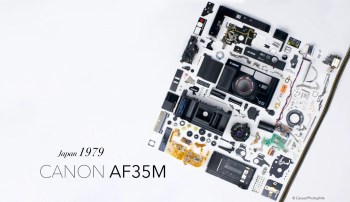
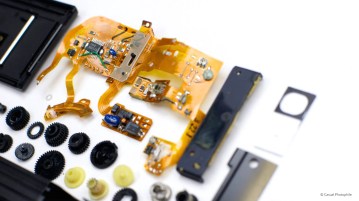
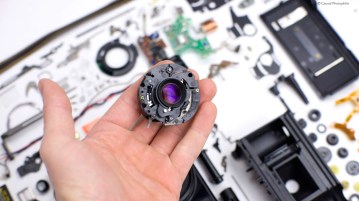
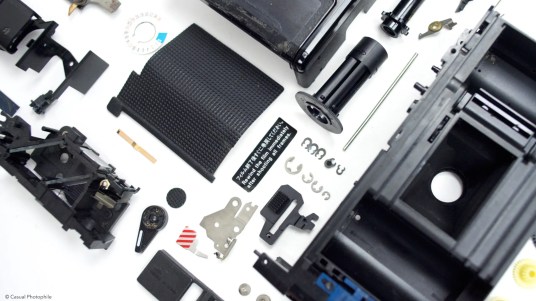
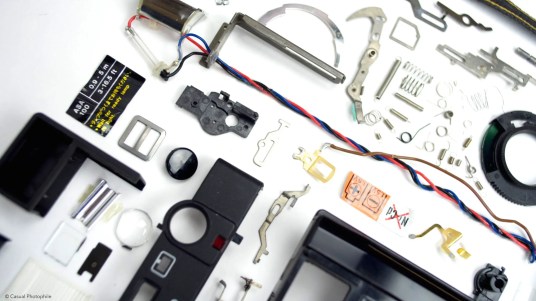
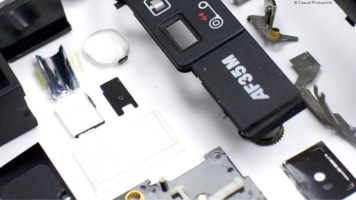
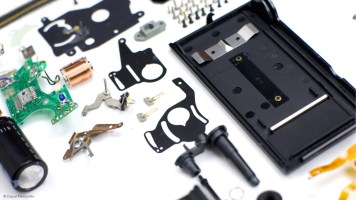
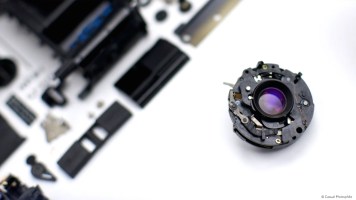
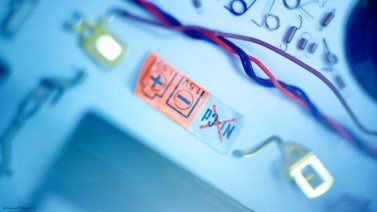
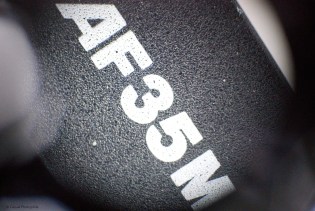
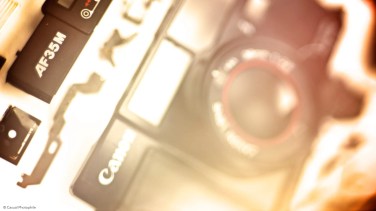

Hi! I have a mkII on which the lens shield won’t open. I am trying to open the whole camera up but the pre-focus lever seems to be in the way to remove the front. Do you happen to remember how you removed it on this model or what could be the reason the shield isn’t opening?